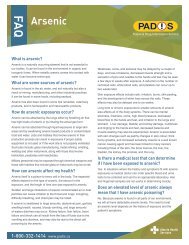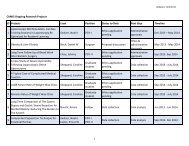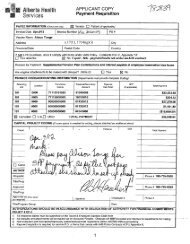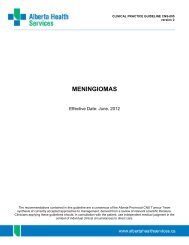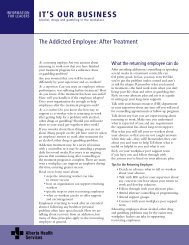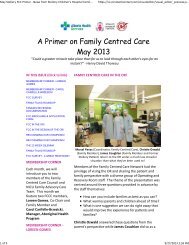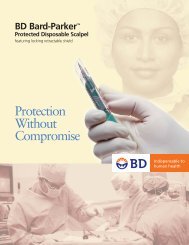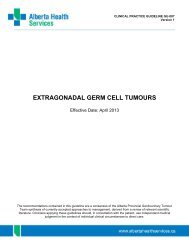taxanes in metastatic breast cancer - Alberta Health Services
taxanes in metastatic breast cancer - Alberta Health Services
taxanes in metastatic breast cancer - Alberta Health Services
Create successful ePaper yourself
Turn your PDF publications into a flip-book with our unique Google optimized e-Paper software.
DISCUSSION<br />
Recommendation #1<br />
Recommendations from exist<strong>in</strong>g guidel<strong>in</strong>es<br />
CLINICAL PRACTICE GUIDELINE BR-001<br />
s<strong>in</strong>gle agent<br />
. 6 The NICE guidel<strong>in</strong>e<br />
atients. 7<br />
The CCO guidel<strong>in</strong>e recommends that patients who would be offered treatment with a<br />
anthracycl<strong>in</strong>e could also be offered s<strong>in</strong>gle agent docetaxel 100 mg/m 2 every 3 weeks<br />
does not give guidance with respect to s<strong>in</strong>gle agent <strong>taxanes</strong> <strong>in</strong> anthracycl<strong>in</strong>e naïve p<br />
The BCCA and CECOG statements<br />
do not recommend a s<strong>in</strong>gle agent taxane as <strong>in</strong>itial therapy <strong>in</strong> a patient<br />
9, 11<br />
who is anthracycl<strong>in</strong>e naïve and who has <strong>metastatic</strong> <strong>breast</strong> <strong>cancer</strong> where HER2 is not over-expressed.<br />
The NCCN does not differentiate anthracycl<strong>in</strong>e-naïve and pre-treated/resistant<br />
patients but suggests that<br />
a variety of s<strong>in</strong>gle agent taxane regimens can be considered. 10<br />
Other evidence considered by this panel<br />
le agent<br />
n = 919) from three<br />
l<strong>in</strong>e were 1.01 (CI 0.97rates<br />
were similar: 38% for the s<strong>in</strong>gle<br />
agent taxane and 33% for the s<strong>in</strong>gle agent anthracycl<strong>in</strong>e. Piccart et al 12 po<strong>in</strong>t out that there was<br />
survival for the<br />
he EORTC trial 14 that<br />
weeks. The metaof<br />
the same three trials<br />
l were found. Ghersi et al, 13 Two meta-analyses have looked at the question of s<strong>in</strong>gle agent <strong>taxanes</strong> versus s<strong>in</strong>g<br />
anthracycl<strong>in</strong>es. The meta-analysis by Piccart et al pooled <strong>in</strong>dividual patient data (<br />
randomized trials.<br />
however, looked at time to<br />
s.<br />
12 The hazard ratios for the taxane compared with the anthracyc<br />
1.26) for death and 1.19 (CI 1.04 – 1.36) for progression. Response<br />
significant heterogeneity with respect to the f<strong>in</strong>d<strong>in</strong>g of improved progression free<br />
anthracycl<strong>in</strong>e compared with the taxane, and that this result was largely driven by t<br />
compared paclitaxel 175 mg/m 2 every 3 weeks with doxorubic<strong>in</strong> 75 mg/m 2 every 3<br />
analysis by Ghersi et al extracted data from published trials. 13 In their analysis<br />
exam<strong>in</strong>ed by Piccart et al, 12 similar resu ts<br />
progression and did not f<strong>in</strong>d a difference between the taxane and anthracycl<strong>in</strong>e arm<br />
With respect to toxicities reported <strong>in</strong> the trials <strong>in</strong>cluded <strong>in</strong> the meta-analyses, there was<br />
more sensory<br />
peripheral neuropathy <strong>in</strong> the taxane arms, but more febrile neutropenia, mucositis, nausea/vomit<strong>in</strong>g,<br />
cardiac failure and toxic deaths <strong>in</strong> the anthracycl<strong>in</strong>e arms. alyzed <strong>in</strong> all three of<br />
he toxicities of<br />
14-16 Quality of life was an<br />
the trials and there was no significant difference <strong>in</strong> the treatment groups with respect to physical, social<br />
and emotional function<strong>in</strong>g, and relationship with physician. 14-16 In one of the trials, t<br />
doxorubic<strong>in</strong> were offset by better symptom control. 14<br />
In the systematic reviews, the <strong>taxanes</strong> have not been compared <strong>in</strong> subgroup analyses. In the EORTC<br />
trial 14 <strong>in</strong>cluded <strong>in</strong> the meta-analyses, overall survival was <strong>in</strong>ferior <strong>in</strong> the paclitaxel group (15.6 versus 18.3<br />
months). One phase III trial randomized patients with anthracycl<strong>in</strong>e-pre-treated <strong>metastatic</strong> <strong>breast</strong> <strong>cancer</strong><br />
to receive either docetaxel 100 mg/m 2 or paclitaxel 175 mg/m 2 every three weeks. 17 Overall survival and<br />
time to progression was significantly better for the docetaxel arm at the expense of greater hematologic<br />
and non-hematologic toxicities.<br />
The current panel agreed to <strong>in</strong>clude weekly taxane regimens as options. The evidence and rationale is<br />
largely drawn from the anthracycl<strong>in</strong>e pre-treated sett<strong>in</strong>g and is discussed under Recommendation #3.



